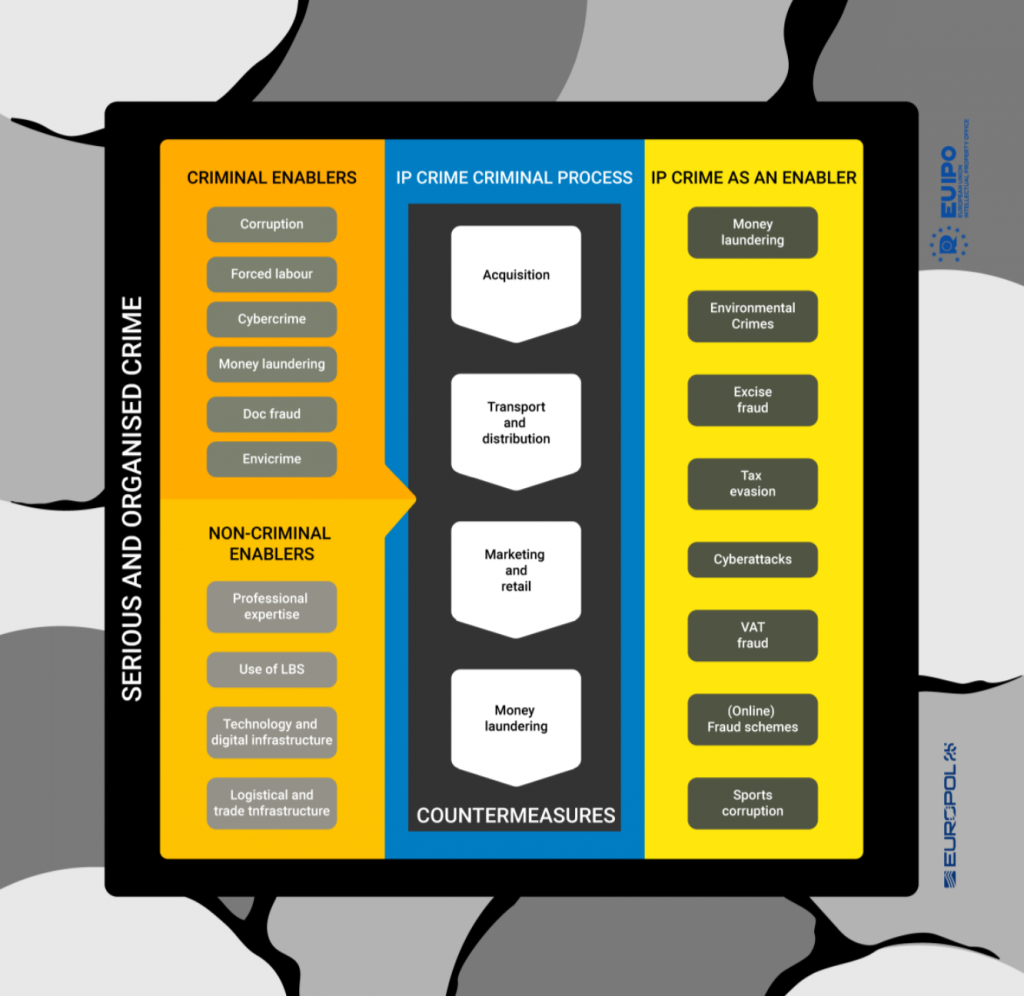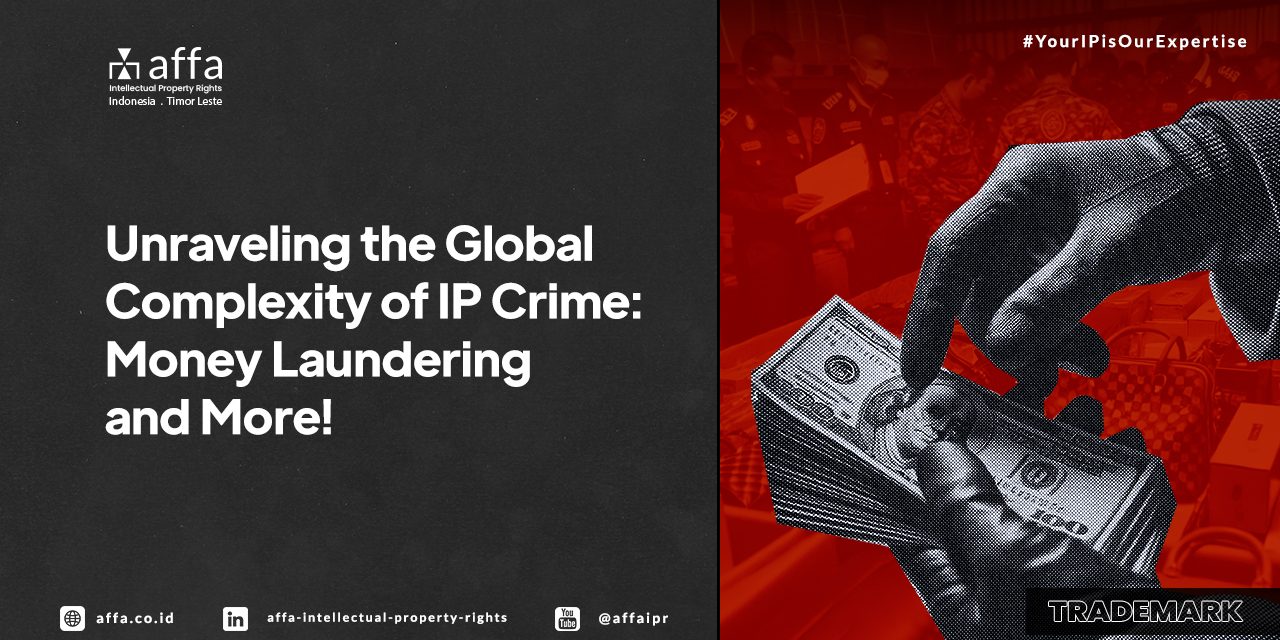Intellectual Property (IP) Crime negatively impacts the economy and consumer safety and has become structurally more complex, posing a worldwide threat to economic and social security.
According to the recently released report “Uncovering the Ecosystem of Intellectual Property Crime,” published this October by the European Union Agency for Law Enforcement Cooperation (Europol) and the European Union Intellectual Property Office (EUIPO), it is revealed that 6% of imported products entering the European Union are counterfeit, with a value exceeding 2 billion euros) annually. This figure represents only the seized products, mainly packaging materials, toys, cigarettes, and CDs/DVDs. Imagine if we could account for the undetected counterfeit goods distributed worldwide.
So, why is tackling IP crime so challenging? The report highlights that this form of crime is highly networked and involves corrupt officials, money laundering, and even tax officers. EUIPO labels these facilitators as IP Crime Enablers!
How significant is their role, and how do they perpetuate Intellectual Property crime? Here are the details.
Intellectual Property Crime – The Definition
In the document, “IP Crime” refers to illegal activities involving the theft, infringement, or unauthorized use of Intellectual Property (IP) rights, which include Copyrights, Industrial Designs, Trademarks, Patents, Geographical Indications, and Trade Secrets. The document categorizes IP crime primarily as:
- Counterfeiting
Manufacturing, importing, distributing, storing, or selling goods that bear the Trademark of a genuine brand without permission.
Examples:
-
- Counterfeit Pharmaceuticals: Production and distribution of fake pharmaceutical products that can pose severe health risks to consumers. For instance, counterfeit Semaglutide injection pens falsely labeled as containing the active ingredient were found to contain other substances, leading to serious health incidents.
- Counterfeit Automotive Parts: The production and distribution of fake automotive parts, like brake pads and wheel rims, infringe Trademarks and pose serious safety risks.
- Piracy
Unauthorized copying, use, reproduction, and distribution of materials protected by IP rights, such as digital media, software, and entertainment.
Example:- Digital Piracy: Illicit streaming services that distribute copyrighted content (like movies and sports events) without authorization. In one case, a streaming service was operating across multiple countries, generating significant revenue through illegal broadcasts.
The Mechanics of IP Crime
IP criminals exploit weaknesses in the global supply chain, legal loopholes, and infrastructure to operate with resilience and evade law enforcement efforts. This structured approach allows them to profit significantly while remaining difficult to prosecute due to their operations’ multi-jurisdictional and often hidden nature. The structured process criminal networks use to conduct IP crimes ranges from obtaining infringing items to laundering the proceeds. Here are the key phases:
- Infringing IP Rights (Acquisition Phase)
This is the initial stage where IP rights are intentionally violated. Criminals produce counterfeit goods by replicating brand logos, labels, or pirated content. This phase may involve either manufacturing counterfeit products directly or diverting legitimate products from the supply chain. Common sources for counterfeit goods include China, Hong Kong, and Türkiye. - Transportation and Distribution Phase
After acquiring the counterfeit items, networks transport them globally, often abusing the legal logistical and shipping sectors to move goods across borders. Criminals use sophisticated smuggling techniques, including splitting shipments and hiding counterfeit items within legitimate products to avoid detection. - Marketing and Retail Phase
Criminals use both online and offline methods to market and sell counterfeit products. Online marketplaces, social media platforms, and even the dark web provide anonymity and access to large audiences. Offline, counterfeit goods may also be sold through physical retail outlets or open markets. - Dealing with Profits and Risks (Money-Laundering Phase)
The final stage involves managing the profits from these illegal sales. Criminal networks employ money laundering techniques to disguise the origins of their profits. This includes investing in legal businesses, conducting physical cash transfers, or using complex digital financial systems to reintegrate funds into the economy.
Parties Also Involved in Intellectual Property Crimes
In addition to the 4 (four) phases of crime above, Europol and EUIPO mapped the parties involved in IP crimes, making these crimes complex and challenging to eradicate.
 Criminal Enablers
Criminal Enablers
These are illegal activities or crimes that help facilitate IP crime:- Corruption: Bribery or manipulation within organizations to ease illegal processes.
- Forced Labour: Exploitation of labor, often under inhumane conditions, to produce counterfeit goods.
- Cybercrime: Digital crimes that support IP crime, such as phishing, malware, or data theft.
- Money Laundering: Concealing the profits from IP crime by converting illegal earnings into legitimate assets.
- Document Fraud: Creating fake documents to disguise the origin or legitimacy of counterfeit goods.
- Environmental Crime (Envicrime): Illegal activities that harm the environment, often associated with the improper disposal of waste from counterfeit production.
- Non-Criminal Enablers
These are lawful activities or structures that criminals misuse to facilitate IP crime:- Professional Expertise: Use of skills from professionals (e.g., lawyers, technicians) to support illegal IP activities.
- Use of Legal Business Structures (LBS): Legal businesses that provide a front for illegal IP activities, such as follows:
- Trading Companies or Factories
These legitimate businesses can be set up or inserted into the supply chain to disguise the production or distribution of counterfeit goods. Factories or production sites can be used to produce counterfeit goods under the guise of legitimate products. - Warehouses or Logistics Service Providers
Legitimate warehouses or logistics companies can be used to store or transport counterfeit goods without raising suspicion. For example, counterfeit goods can be hidden among legitimate products in international shipments. - Physical Retail Stores
Appearing legitimate stores can be used to sell counterfeit goods to consumers without their knowledge. Counterfeit goods can be sold alongside legitimate products, making it difficult for consumers to tell the difference. - Online Stores or Marketplace Platforms
Many IP criminals use e-commerce websites or accounts on platforms like Amazon, eBay, or social media to sell counterfeit products. These platforms often give the impression of a legitimate business, making it easier for criminals to reach consumers at a wide range. - Front or Shell Companies
These companies are technically legitimate but serve only as a front for illegal activity. They are often used to launder money or hide proceeds from IP crimes. - Pharmaceutical Business or Pharmacy
In the case of pharmaceutical crime, pharmacies or pharmaceutical companies can be used to obtain or sell counterfeit pharmaceutical products or drugs diverted from the legal supply chain.
- Trading Companies or Factories
- Technology and Digital Infrastructure: Use of advanced technology like 3D printing or digital platforms to create or market counterfeit goods.
- Logistical and Trade Infrastructure: Legal logistics systems, such as shipping and storage, that criminals exploit to transport counterfeit goods.
- IP Crime as an Enabler
IP crime can facilitate or support other forms of crime: -
- Money Laundering: Allows for the flow of illegal profits.
- Environmental Crimes: Counterfeit production often disregards environmental regulations, leading to illegal waste disposal.
- Excise Fraud and Tax Evasion: Counterfeit goods bypass taxes and duties, leading to significant revenue loss.
- Cyberattacks: IP crime, especially digital piracy, is associated with cyber threats like malware.
- VAT Fraud: Avoiding Value Added Tax through the illegal trade of counterfeit goods.
- Online Fraud Schemes: Fake e-commerce platforms or phishing scams tied to counterfeit sales.
- Sports Corruption: Counterfeit goods like unauthorized pharmaceuticals or supplements can be linked to doping or match-fixing.
7 Steps to Combat Intellectual Property Crime
Europol and EUIPO specifically emphasize the importance of a collaborative and strategic approach to address IP crime, as follows:
- Strengthening Collaboration and Cooperation Among Stakeholders
Law enforcement, policymakers, the private sector, and the public must work together to combat IP crime. This collaboration is essential for identifying criminal networks, strengthening legal processes, and accelerating actions against IP crime offenders. - Raising Public Awareness
The public needs to be better informed about the risks of purchasing counterfeit products, in terms of health, safety, and economic impact. Public awareness campaigns can help reduce demand for counterfeit goods and increase consumer vigilance. - Enhancing Detection Technology
Law enforcement and Trademark owners can use advanced technology, such as Artificial Intelligence (AI), to quickly identify counterfeit products. This technology can also assist online platforms in flagging suspicious products and preventing counterfeit sellers from operating. - Strengthening Regulations and Law Enforcement
Legislation related to IP crime must be reinforced to impose stricter offender penalties. Stronger law enforcement, including tighter border control measures and greater international cooperation, can reduce opportunities for criminals to smuggle counterfeit goods. - Implementing Security Technology on Genuine Products
Trademark owners can incorporate security features on their products, such as QR codes or Near-Field Communication (NFC) technology, allowing consumers to verify the authenticity of products. This measure helps consumers identify genuine products and avoid counterfeits. - Promoting Transparency in the Supply Chain
Increasing transparency and oversight in the supply chain can reduce opportunities for criminals to introduce counterfeit products into the market. This includes tracking the origin and distribution paths of products to ensure each item sold is genuine. - Financial Investigation and Money Laundering
Conducting in-depth investigations into the financial flows of criminal networks involved in IP crime can help identify and cut off their funding sources. Money laundering is often an integral part of IP crime, and criminal networks can be weakened by disrupting the flow of money.
By understanding the mechanisms, enabling factors, and impact of IP crime, it becomes clear that a collaborative and comprehensive approach is essential to countering this threat. Public education, strengthened regulations, advanced technology, and multi-stakeholder cooperation are key to overcoming this challenge. As an Intellectual Property Lawyer, we are committed to continuously raising awareness and understanding among the public about the importance of protecting IP rights, preserving market integrity, and ensuring consumer safety.
Should you need more information regarding Intellectual Property protection in Indonesia or abroad, you can contact us via email: [email protected].
Source:








1 Comment